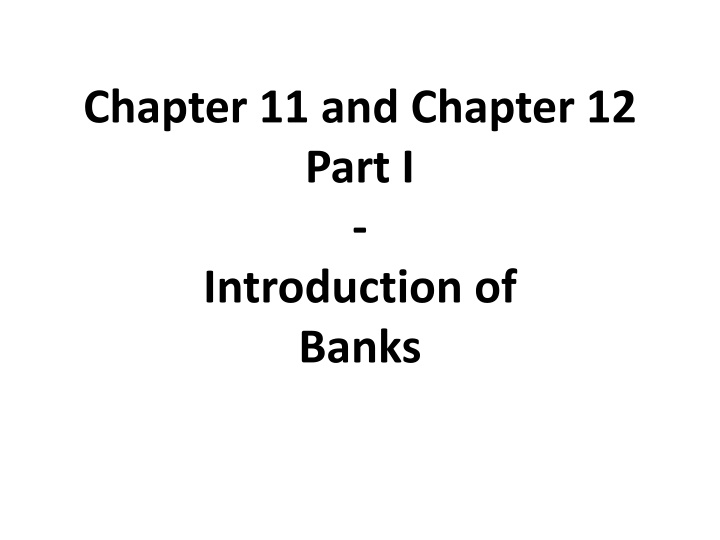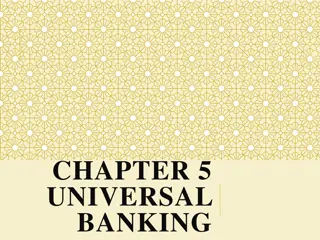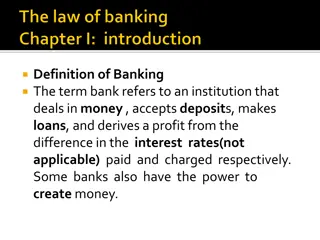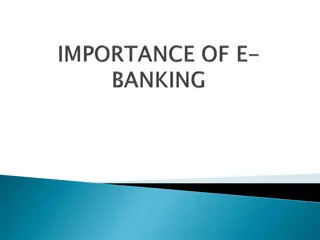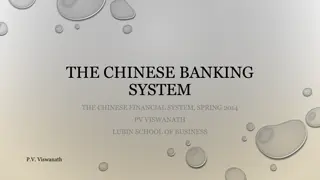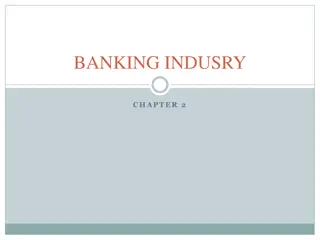Evolution of Banking Industry: From Origins to Modern Challenges
Explore the history and evolution of the banking industry from its early origins, such as the banking practices in ancient Sumeria and Song Dynasty China, to the establishment of modern banking systems in Italy and the UK. Learn about the key characteristics of banks, the role of interest rates, the emergence of different bank types, and the challenges faced by the industry, including banking crises and regulatory measures.
Download Presentation

Please find below an Image/Link to download the presentation.
The content on the website is provided AS IS for your information and personal use only. It may not be sold, licensed, or shared on other websites without obtaining consent from the author.If you encounter any issues during the download, it is possible that the publisher has removed the file from their server.
You are allowed to download the files provided on this website for personal or commercial use, subject to the condition that they are used lawfully. All files are the property of their respective owners.
The content on the website is provided AS IS for your information and personal use only. It may not be sold, licensed, or shared on other websites without obtaining consent from the author.
E N D
Presentation Transcript
Chapter 11 and Chapter 12 Part I - Introduction of Banks
What is bank? Bank originally means: counter or table cloth In 15thcentury Bank s characteristics: Spread income margin core business Borrow @ low interest rate from depositor Lend @ high interest rate as loan Liquidity inventor Bank borrow for short term and lend out for long term Long term is locked up but short term is cashable at anytime Bank run is inevitable Notes issuer in the past This role was replace by government bank Two areas still allow private banks to issue notes HK and UK
History of Banking Industry Interest rate appeared in 2000BC in Sumerian. Guess what did interest rate mean at that time? First record of interest rate was in Song Dynasty in year 940 in China. Modern bank appeared in Italy in year 1472, Banke Monte Dei Praci de Siena in Siena, still operating Deposit insurance appeared in this bank, insured by a Duke for all deposits.
History of Banking Industry (II) In UK, in 16th century, gold smith banker Took gold from depositors and issued notes Notes were used to buy merchandise with endorsement So one note passed around with many endorsement Eventually, only bearer's name appeared in the note Banking started from here in UK
Banking Industry Crisis Bank run Moral hazard of banks How to avoid banking industry crisis? Government regulation Deposit insurance
Major Bank Types Commercial Banks Take deposits and make out loans In 2010, $104 trillion assets for all US located banks Only $10.1 trillion for US chartered banks Saving banks In 2010, total assets are $1.2 trillion Old style institution but grows very slow Credit unions $0.9 trillion in 2010. Like clubs
Theory of Banks Diamond and Dybvig model, JPE, 1988. Banks are liquidity provider Banks product is liquidity Under normal and bad economy, depositors expect different from banks Multi-equilibrium exist Their model explains bank run as one state of equilibrium. Recent crisis was due to real estate bubble, causing failure of banking system So hard to keep banks under control and Diamond s model has its limits.
Why do we need bank? Adverse selection problem How can depositors identify borrower? Bankers are financial intermediary Familiar with community Supervise borrower Expert as loan officer
Why do we need bank? (II) Moral Hazard problem Borrowers can make wild investment with depositor s money. With bank as monitors and experts Business ties force borrowers to obey rules Banks lend out on short term, so borrowers are disciplined.
How to avoid bank run? Need deposit insurance Started in 16th century in Italy. Deposit insurance scheme backed up by governments failed many times in history FDIC, Federal Deposit Insurance Corporation Started in 1933 initiated by President Franklin Roseville Never failed, because people believe in it. FSLIC saving bank insurance failed S&L crisis in 1980s and US gov bailed it out for $150 billion but FSLIC was gone.
Bank Regulation Bankers also have moral hazard Basel I, 1988; Basel ii, 2000; Basel iii, 2010 Basel is located in Switzerland Basel committee has no authority but it makes worldwide recommendations of bank regulation. Banks are now interlinked Most recommendations are adopted worldwide
Bank Regulation (II) Basel II, 2000 Basel II was incurred because of more and more complicated financial markets, such as derivatives. But Basel II failed and resulted in financial crisis Basel iii, 2010 Will be phased out in full in 2019. Medium-term impact of Basel III implementation on GDP growth is in the range of 0.05% to 0.15% per year.
Why Arent Banks Lending to Small Business? In Basel I and also in Basel II and III Capital requirement of assets is based on risk level of assets Risk level Example 0% OCEP gov bond, US gov bond 20% Muni issued by city, state, and Fannie and Freddie 50% Mortgage 100% Anything else such as loans to business Fannie and Freddie issue sub-prime loans Even though not stated anywhere, people believe Fannie and Freddie are backed up by US gov. They are still rated with 20% of capital requirement.
Why Arent Banks Lending to Small Business? (II) Imagine a bank with $400 million assets in balance sheets 100 million gov bond 100 million Fannie 20% capital requirement 100 million mortgage 50% capital requirement 100 m loan to small business 100% capital requirement 0% capital requirement How much is the total risk weighted assets? (170 million)
Why Arent Banks Lending to Small Business? (III) How much is the total Basel III requires Common equity must be 4.5% of Risk weighted assets (RWA) Plus 2.5% of capital conservation buffer So total 7% of capital requirements How much is the bank s capital requirement with $170m RWA? ($11.9million)
Why Arent Banks Lending to Small Business? (IV) How much is the total Basel III requires Common equity must be 4.5% of Risk weighted assets (RWA) Plus 2.5% of capital conservation buffer So total 7% of capital requirements How much is the bank s capital requirement with $170m RWA? ($11.9million)
Why Arent Banks Lending to Small Business? (V) This $11.9 million should be lower than the common equity component in balance sheet Assume this bank common equity is $12.9million It has one extra million that can lend out How? Can buy $70m worth of Fannie (1million / (20%*7%)) Can lend out only $14m to small business (1million / (100%*7%)) Of course, board of bank will choose to buy Fannie
Critiques of Basel Encourage banks to buy sub-prime loan instead of lending to small business Basel committee s defense Basel is to regulate banking industry to avoid bank run.
Banking Industry Crisis Worldwide Mexico crisis in 1994 and 1995 Lending boom, 10% of GDP is lending in 1988 40% in 1994 Bubble and boom without regulation Government cannot bail out every bank Mexican banks were destroyed and taken over by foreign banks.
Banking Industry Crisis Worldwide (II) Asian Crisis in 1997 and 1998 Before the crisis, international banks heavily lend out to Asian governments International banks pulled out capital, causing bank runs in those countries Hit Thailand, Korean, Indonesia, Russia and Brazil.
Conclusion Banks provide liquidity so that individual and business both function well. Banks solve adverse selection and moral hazard. Banks should be regulated. With financial market getting more and more complicated, who should be regulated.
